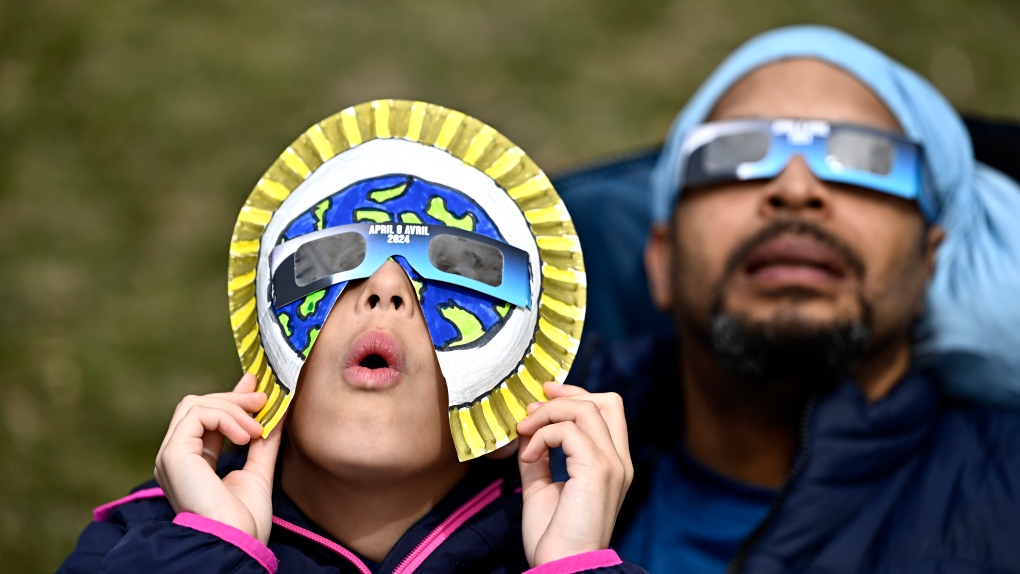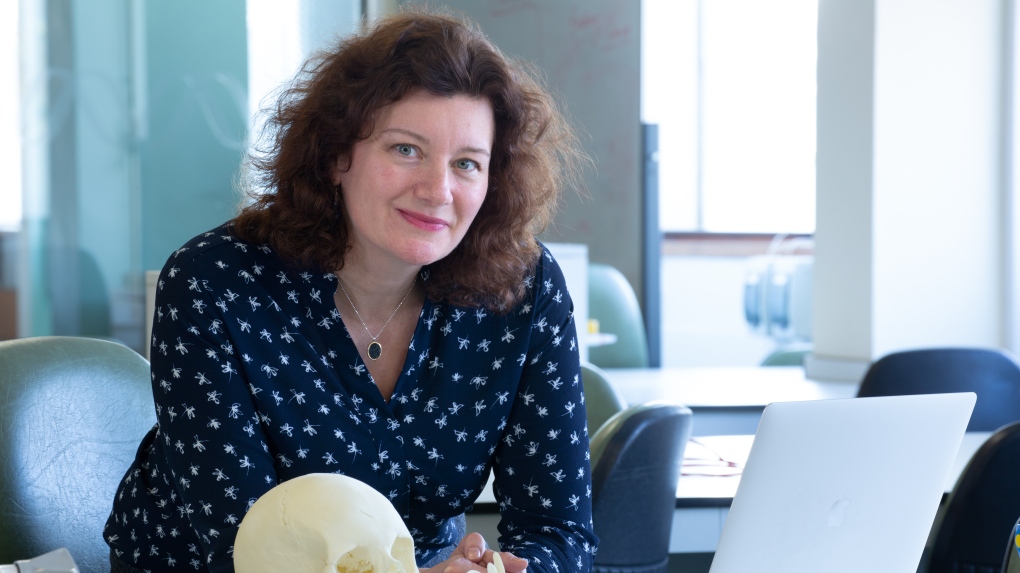If you watched Monday’s solar eclipse, you may be wondering whether you damaged your eyes.
Eye-care and astronomy experts said it was safe to view the sun directly during the brief moment of totality when the moon fully covered it since there would be no ultraviolet rays. For the partial eclipse phase, however, people were urged to use eye protection such as eclipse glasses, specialized solar filters and handheld solar viewers.
“You’re not getting those same UV rays and that is why it was safe to remove your eclipse glasses during totality,” Dr. Shaina Nensi, vice-president of the Ontario Association of Optometrists in Toronto, said in a video interview with CTVNews.ca on Tuesday. “Only in the moments leading up to totality and in the moments after totality, the eclipse glasses and eclipse shields did need to be put back on.”
CTVNews.ca spoke with eye-care experts to find out what to do if you have concerns about your eyesight after observing the rare celestial event.
Symptoms of eye problems
Nensi says you could experience a few conditions if you observed the eclipse without eye protection.
Solar retinopathy is a more common problem associated with watching the rare phenomenon and isn’t usually associated with eye pain.
If you burned your retina, you could experience solar retinopathy symptoms as mild as watery eyes or light sensitivity or as severe as blurry or distorted vision and a scotoma, or blind spot, where you see a dark spot in your central vision.
“It is essentially a sunburn in the eye and so the layers of the retina in the back of the eye can be damaged,” Nensi said, noting the main symptom is “vision disturbances.”
“The reason you get solar keratitis or solar retinopathy is because of the UV rays from the sun. … We can get these burns in our eyes if we stare at the sun for too long without eye protection.”
Dr. Martin Spiro, president of the Canadian Association of Optometrists, says those who are having visual problems, discomfort or pain in their eyes should see their optometrists.
The effects of solar retinopathy can happen within hours or one to two days after viewing the eclipse, said Spiro, who is based in Montreal.
Since the retina doesn’t have pain receptors, you won’t typically feel any eye pain if you have solar retinopathy, Nensi said. “So you could be experiencing these visual symptoms without actually being in any pain or discomfort.”
Some people may experience solar keratitis, an ultraviolet burn on the front surface of the eye that can result in pain because of pain receptors in the cornea.
Solar keratitis is not commonly associated with viewing the eclipse, but if the condition does occur symptoms will show up sooner, Nensi said.
This condition, which tends to be temporary, causes irritation or grittiness in the eyes, Spiro said.
Dr. Alexis Keeling, president of the New Brunswick Association of Optometrists, says it may be too soon to know if patients have developed solar retinopathy as it can take 24 to 48 hours for symptoms to appear.
Keeling, who is based in Dieppe, N.B., says there are no reported cases yet in New Brunswick as of Tuesday.
Those who damaged their eyes after looking at the eclipse should have noticed a problem when they woke up the next day, she explained.
“Like a sunburn that shows up hours after, they would’ve called this morning upon waking up and would have noticed a big dark spot called a scotoma or a blind spot in their central vision,” she said in a phone interview with CTVNews.ca on Tuesday.
For instance, people with solar retinopathy wouldn’t be able to see someone’s nose. Instead, they would only see objects in their peripheral vision, such as a person’s eyes or chin, she added.
What if you looked at the sun briefly?
Those who viewed the sun directly without eye protection, but only briefly, could still experience eye damage.
“If they think they just glanced up at it for a fraction of a second, the chances are less likely that they would experience any solar retinopathy,” Nensi said, though she added that it can take just a few seconds to cause solar damage to the eye.
“The duration of time that you would have had exposure before causing solar retinopathy is actually variable in different individuals.”
The risk of developing the condition includes other factors such as pupil size and eye colour, Spiro said.
“So if the pupil is larger, more of the sun’s rays will get to the back of the eye,” he explained.
He said paler eyes tend to be more transparent, increasing the risk of developing solar retinopathy. “So the higher pigmentations could be a little bit more protective of the structure of the back of the eye as well.”
What happens if you’re diagnosed with solar retinopathy?
No treatment exists for solar retinopathy, Spiro said.
But an optometrist can help people manage the symptoms, Nensi says. “The optometrist can suggest certain supplements or certain vitamins to increase in their diet to help healing along.”
For those experiencing solar retinopathy, it can take anywhere from one to six months to heal, Nensi said.
“You’ll likely be monitored on a regular basis to make sure that your retina is improving as it should,” she said. “And your optometrist can help you manage those symptoms as you go through recovery.”
If the damage is permanent, Spiro says, there are ways to improve vision, such as through high-powered glasses and magnifiers.
What are the chances of going completely blind?
More serious cases, usually involving prolonged exposure to the sun, can lead to permanent damage.
“Those are the cases that often have irreversible solar retinopathy or irreversible blind spots in your vision,” Nensi said. “Often those symptoms do improve, they just might not go away entirely.”
Despite some cases of irreversible eye damage, the chances of going completely blind from solar retinopathy is “very rare,” Nensi said. “So it is rare for you to lose your vision entirely and it is more common for you to lose portions of your vision or to have scotomas (or) missing portions of your vision because of solar retinopathy.”
More concerns a day after eclipse
Keeling says she’s not anticipating a spike in the number of people seeking help for eye problems related to the eclipse.
So far, she says patients in New Brunswick have only sought help or advice from optometrists for eye problems not related to the celestial phenomenon.
“It’s just a regular day,” she said.
Nensi, however, says she received many calls to her clinic Tuesday morning from parents who are concerned their children may have not used the eclipse glasses correctly. “So it is just Day 1, of course, after the solar eclipse, but I can tell from chatting with my colleagues and looking at my schedule this afternoon, there are certainly some people that are concerned that they either removed their safety glasses at the wrong time or did glance up at the eclipse without any eye protection.”
She says some of her colleagues have patients who are already experiencing scotomas or blind spots in their vision.
“There has certainly been an increase in the number of patients calling wanting to have their eyes assessed because of the eclipse,” she said.




